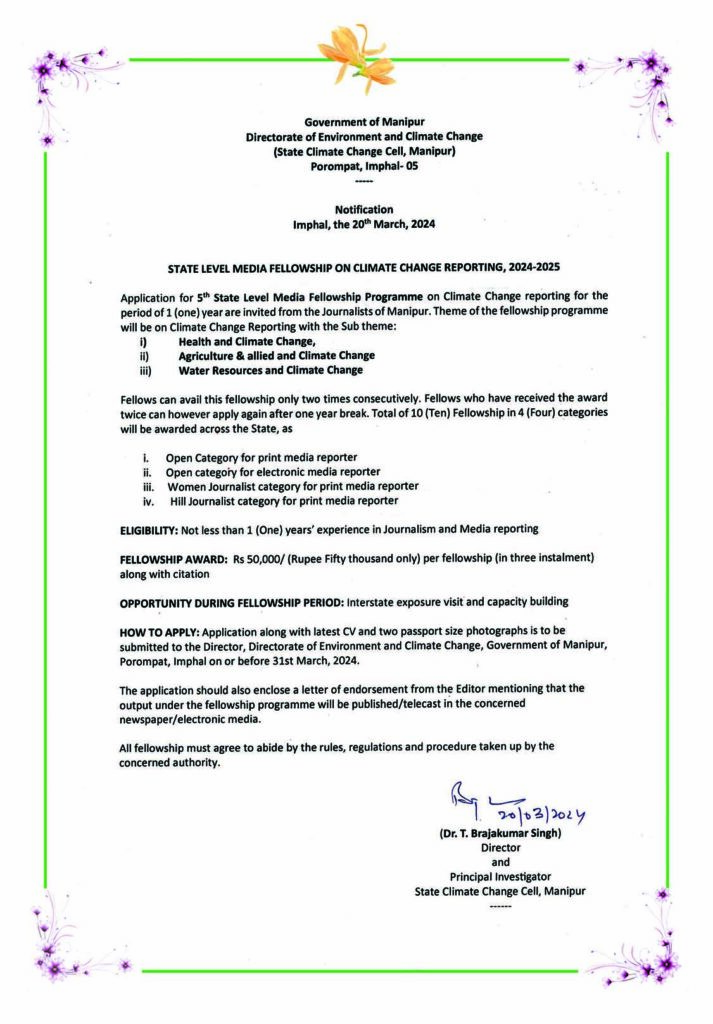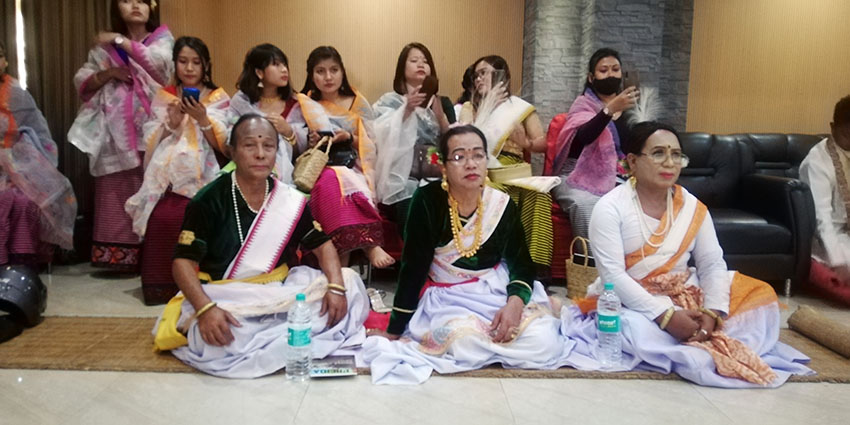It is sad, and also alarming, to notice that the ever so culturally rich Manipur is leaning towards the temporal in this contemporary age. The process of assimilation which is so intrinsically rudimentary to any depiction of Manipuri life in its refinement, has during this period, lost some of the forms which have sustained this culture over many previous ages. So that the commonplaceness of life and its events are no more uplifted or celebrated in the cultural fulfilment of Manipur’s continuing generations of masses. We may then ask how much touch we have lost with the people of this land, and is this chasm between the artist and the common men already insurmountable. And do we recollect that the ritual of physical movements in both individual and societal expression is caused by the freedom of spirit, or that this freedom of spirit is not extended popularly by the definitions of a few, but is elemental to man, nature, society and religious laws as much as all these were born from it in abundance. It’s a pity that we are slowly unsubscribing from the past, thinking we can find our identity in the present, which we are completely overawed with, unfortunately for all of us.
What has newly arrived then is a trial where the whole of the cultural audience is being made familiar to beauty without distinctions, so that the impression given to the viewer is that only the fair is beautiful, the skin or gene only is to be preserved, and this with an preposterous attempt carried too far to allow a fair share of this kind of definition of beauty to all and sundry, as if all Manipur could gather from these times was the sheer sensuality of it all and nothing else remained to be perused in the soul ever in the past. The charming commonality of the content of culture is lost, as it is now mistaken for exclusivity as a form.
The attempt to culturally restructure Manipur is the worst that could have happened in Manipur. In this intermediary period we saw movies being produced in morally condemnable sites like Bangkok, or a costumes shift in performing arts that ridicules the audience of being color blind or without better taste, or quite ridiculously trying to celebrate art forms as a mass movement minus the self-composure that knits together social sanctity. And here let’s come to the main subject matter of this write-up, which is the ongoing attempt to exclude a revered figure in yesteryear’s life in Manipur, the Nipa Maibis, from participation in the Lai Haraoba festival which is the mainstay of Manipuri religious practice, including the performing art forms. Sensuality has creeped into shamanistic practices via radicalism and good looking women are being promoted to take on the role of the traditional Nipa Maibi.
A ‘One-day workshop on Lai Haraoba for Nipa Maibis’ was organised by the Solidarity and Action against HIV Infection in India (SAATHI) and the All Manipur Nupi Maanbi Association (AMANA), in collaboration with the Manipur University and the Amaibi Loishang at the Yaiphaba Hotel in Imphal this week to discuss the role of Nipa Maibis and also the matter of the frequent threats given to them by certain proscribed groups and the Umang Lai Kanba Lup (UKAL), which are unduly censuring the Nipa Maibis from participating in the Lai Haraoba festival, claiming the Nipa Maibis cannot wear the feminine dress for the rituals and performances. But the fact remains, according to the Nipa Maibis themselves that they have had this personalised experience with the supernatural from as early as 10-15 years age, called ‘Lai-tongba’, or becoming a medium for supernatural experiences, and have been part of this tradition from early on. Basically they depend for whatever livelihood they have by performing pujas and other arts and ritual forms when they are invited by common people, apart from this process of communication with the supernatural elements being a spiritual need, or compulsion, for them. The threat from the said groups aims at trying to afford solemnity to the Nipa Maibis themselves, and the holy shamans are having a bad time, although even at this function, at least one of them did not hold back from humorously making fun of those who are against them, making the audience of elders, students, children and families smile and laugh at the wisdom contained in those jokes.
There’s no competition in arts or religion, it would be good for detractors of this age-old system of socially accepted way of life in Manipur to know. It’s the Nipa Maibis traditional way of life and livelihood and nobody has questioned them in Manipur even during the most refined years of its cultural ethos. How can a person be told how to conform to a particular way of life. One shouldn’t get mixed up about the definition of law and a particular way of life. We can have a law against criminal acts, but not legally dwell on a citizenry’s personal choices. We can’t go above social conduct and disregard even the law of the land which in this case gives recognition to the Nipa Maibis. In arguing against and threatening the Nipa Maibis even with death and ostracisation, these opposing groups are themselves being unlawful, as if they are above any kind of law. Why can’t people in Manipur or elsewhere accept people as they are? Why do the above mentioned groups want the Nipa Maibis to better one’s own selves? How’s that possible, or why expect that from the Nipa Maibis who have been brought up and grown up the way they are. Armed groups or people who are sanctioned by them cannot have a free run over any matters of community dress codes.
In art or religion the inner human content and its public expression is more important and intrinsic to the way an artist or a spiritual person acts or lives like. This space is becoming more and more restricted in Manipur, even as the community allowed radical elements to usurp the consolatory role allotted to them in the matter of Nipa Maibis participation in community. This community oversight has led to radicals beginning to believe that community space is determined by them, and that art and religion can be manipulated to suit blunt dictations. And this is where the more informed citizenry needs to reinfuse aesthetic taste in the community by explaining that such subtle pursuits are not to be confused with views external to subtlety, and that these pursuits have higher form, or conform around inner experiences of human beings. Only the spiritual person or an accomplished artist can make us privy to the realm of the supernatural modes in existence, and this the Nipa Maibis are traditionally accustomed to depicting at the Lai Haraoba festival. No one is authorised, except unlawfully or uncustomarily, to try and place restrictions on the Nipa Maibis. Trying to mould the public appearance of Nipa Maibis around rules which are imposed without consulting the law of the land is unremittable, and hence unrecognised.
The attempt at sidelining the Nipa Maibis will only deplete the Manipuri cultural life and have so many consequences; for instance, a disruption of the social fabric leading to a loss of identity, which fact is unfolding noticeably in contemporary times. Just because some groups cannot see the worth of it doesn’t mean that the traditional familiarity of the Nipa Maibis can be interrupted. We all in Manipur need a rethink on this matter because saving the Nipa Maibis from being bullied would deliver us back to the Manipuri way of life and the benefits of a now largely missing structured social freedom, which ensues from spiritual contact with the Nipa Maibis’ priceless contribution to the society here in Manipur. Shamans are recognised and well accepted in other parts of the world too. They are part of Siberian culture, and they are known as the Two Spirits community in North America and the Nat Kadaw in Burma, among others. The shamanistic art in Siberia connects with nature, birds, animal sounds etc., whereas the Nat Kadaw connects with the soul, and in Manipur the various dance forms find relevance through this spiritual practice. The fact is that there are Nipa, Nupi and also transgender maibis and if there’s a case of ‘Maibi-changba’ in a male, which is a female principle, how can that person be told to conform to the role of a ‘Maiba’, or the male principle. It’s complicated, but also easy to understand, if we respect another person’s personalised non-bookish realisations, especially spiritual ones. Knowledge as a qualification is too arrogant and makes it too easy to disregard another person’s views, which may be uncommon and hence unacceptable by that definition. Recognition is certainly due to the Nipa Maibis of Manipur.
Those who were part of the discussions included Prof. Nahakpam Aruna Devi, Dean School of Humanities, Manipur University; Dr. Moirangthem Macha Chaoreikanba, Assistant Professor, Department of Dance and Music, Manipur University; Randhoni Lairikyengbam, Assistant Director, SAATHI; Yangambam Tomba, Asuppa, Luching Purel Nipa Maibi, Amaibi Loishang, Manipur; Thoudam Chaoba Mangang, Sanglakpa, Amaibi Loishang, Manipur, and Abujam Tomba Meitei, Pana Sanglakpa, Amaibi Loishang, Manipur. The program was conducted by S Kondrajit Singh, Research Scholar, Department of Dance and Music, Manipur University, and A Ranjita Devi, Research Scholar, Department of Dance and Music, Manipur University. The hosts were Santa Khurai, Secretary of the AMANA, and Bonita Pebam, also of the AMANA.










